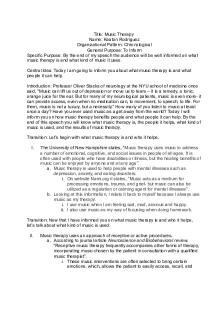Mental health - Informative speech PDF

| Title | Mental health - Informative speech |
|---|---|
| Course | English For Oral Presentations |
| Institution | Universiti Teknologi MARA |
| Pages | 10 |
| File Size | 445.1 KB |
| File Type | |
| Total Downloads | 79 |
| Total Views | 141 |
Summary
Informative speech...
Description
ELC 590: ENGLISH FOR ORAL PRESENTATION
INFORMATIVE SPEECH TOPIC: MENTAL HEALTH PROBLEM
PREPARED BY:
IC2101B MUHAMMAD AZLI BIN ABDUL SANI (2020489236)
PREPARED FOR: MRS. HAMIDAH
24 NOVEMBER 2020
Introduction Introduce topic Mental Health Problem Credibility I am interested in this topic and have done some research on it
Background of topic
Central idea
According to World Health Organization (WHO) reported that Mental Health Problem is already the fourth leading cause of the global disease burden and expected to rank second by year 2020.Mental illness is a common disease that affects a person’s thinking, emotion, behavior and also causes functional impairment The Increase of Mental Ilness in Malaysia is due to many factors
Body (Describing chart[s] and/or graph[s]) Description of data (chart 1) 1. This graph shows the percentage of adults who feel anxiety and stress give the negative impact on mental health during pandemic from March 2020 to July 2020. 2. March 2020 recorded the lowest percentage in adult who feel anxious and stress during the pandemic which is 32% 3. July 2020 recorded the highest percentage in adult who feel anxious and stress during the pandemic (53%).
Analysis of data (chart 1) 1. Studies showed that adults who admit that anxiety and stress related to the pandemic has had a negative impact on their mental health gradually increased from March
2020 to early April 2020.The factors that contributed to this study were the increasing cases of COVID-19 and the Movement Control Order (MCO) that was implemented during the first few months of the battle against COVID-19. 2. A decrease of 6% of adults who say that anxiety and worry related to the pandemic has had a negative impact on their mental health was reported from early April 2020 to May 2020. 3. An increase of 14 % from May 2020 to July 2020
Description of data (chart 2)
1. This graph represents the adults effected by mental illness. 2. Major Depressive Disorder recorded the highest number among mental illnesses.
3. Schizophrenia recorded the lowest number of mental illness. Analysis of data (chart 2)
1. One of the factors leading to Major Depressive Disorder (MDD) during the pandemic was getting fired from their jobs because of the declining growth of economy. 2. Quarantine is mostly likely responsible for the change in one’s unhealthy sleep behaviours or lifestyle. Conclusion
Conclusion
Both graph shows an increase of mental health problem.The increase of Mental Ilness is due to many factors . Research has also shown, in this current situation, it is challenging to accurately predict the psychological and emotional
consequences of COVID-19.
Recommendation To reduce number of people who suffered from this pandemic depression is to get the root of the cause and try to create awareness for the people to get the help that they needed.
GRAPH 1:
GRAPH 2:
Article
The World Health Report 2001: Mental Disorders affect one in four people Treatment available but not being used 28 September 2001 News release Reading time: 4 min (951 words)
One in four people in the world will be affected by mental or neurological disorders at some point in their lives. Around 450 million people currently suffer from such conditions, placing mental disorders among the leading causes of ill-health and disability worldwide. Treatments are available, but nearly two-thirds of people with a known mental disorder never seek help from a health professional. Stigma, discrimination and neglect prevent care and treatment from reaching people with mental disorders, says the World Health Organization (WHO). Where there is neglect, there is little or no understanding. Where there is no understanding, there is neglect. In a new report entitled "New Understanding, New Hope" the United Nations’ health agency seeks to break this vicious cycle and urges governments to seek solutions for mental health that are already available and affordable. Governments should move away from large mental institutions and towards community health care, and integrate mental health care into primary health care and the general health care system, says WHO. "Mental illness is not a personal failure. In fact, if there is failure, it is to be found in the way we have responded to people with mental and brain disorders," said Dr Gro Harlem Brundtland, Director-General of WHO, on releasing the World Health Report.
"I hope this report will dispel long-held doubts and dogma and mark the beginning of a new public health era in the field of mental health," she added. A lack of urgency, misinformation, and competing demands are blinding policymakers from taking stock of a situation where mental disorders fi gure among the leading causes of disease and disability in the world, says WHO. Depressive disorders are already the fourth leading cause of the global disease burden. They are expected to rank second by 2020, behind ischaemic heart disease but ahead of all other diseases. The report invites governments to make strategic decisions and choices in order to bring about positive change in the acceptance and treatment of mental disorders. The report says some mental disorders can be prevented; most mental and behavioural disorders can be successfully treated; and that much of this prevention, cure and treatment is affordable. Despite the chronic and long-term nature of some mental disorders, with the proper treatment, people suffering from mental disorders can live productive lives and be a vital part of their communities. Over 80% of people with schizophrenia can be free of relapses at the end of one year of treatment with antipsychotic drugs combined with family intervention. Up to 60% of people with depression can recover with a proper combination of antidepressant drugs and psychotherapy. Up to 70% of people with epilepsy can be seizure free when treated with simple, inexpensive anticonvulsants. The responsibility for action lies with governments, says WHO. Currently, more than 40% of countries have no mental health policy and over 30% have no mental health programme. Around 25% of countries have no mental health legislation. The magnitude of mental health burden is not matched by the size and effectiveness of the response it demands. Currently, more than 33% of countries allocate less than 1% of their total health budgets to mental health, with another 33% spending just 1% of their budgets on mental health. A limited range of medicines is suffi cient to treat the majority of mental disorders. About 25% of countries, however, do not have the three most commonly prescribed drugs used to treat schizophrenia, depression and epilepsy at the primary health care level. There is only one psychiatrist per 100 000 people in over half the countries in the world, and 40% of countries have less than one hospital bed reserved for mental disorders per 10 000 people.
The poor often bear the greater burden of mental disorders, both in terms of the risk in having a mental disorder and the lack of access to treatment. Constant exposure to severely stressful events, dangerous living conditions, exploitation, and poor health in general all contribute to the greater vulnerability of the poor. The lack of access to affordable treatment makes the course of the illness more severe and debilitating, leading to a vicious circle of poverty and mental health disorders that is rarely broken. The report says new knowledge can have a tremendous impact on how individuals, societies and the public health community deal with mental disorders. We now know that large mental institutions no longer represent the best option for patients and families. Such institutions lead to a loss of social skills, excessive restriction, human rights violations, dependency, and reduced opportunities for rehabilitation. Countries should move towards setting up community care alternatives in a planned manner, ensuring that such alternatives are in place even as institutions are being phased out. "Science, ethics and experience point to clear paths to follow. In the face of this knowledge, a failure to act will reflect a lack of commitment to address mental health problems," said Dr Benedetto Saraceno, Director of WHO’s Mental Health and Substance Dependence department. The policy directions have never been so clear, says WHO. Governments who are just starting to address mental health will need to set priorities. Choices must be made among a large number of services and a wide range of prevention and promotion strategies. WHO’s message is that every country, no matter what its resource constraints, can do something to improve the mental health of its people. What it requires is the courage and the commitment to take the necessary steps. The report is part of a year-long campaign on mental health. For the first time, multiple events at WHO including its premier report, technical discussions at the World Health Assembly and World Health Day, have all focused on one topic – mental health.
Salari et al. Globalization and Health (2020) 16:57 https://doi.org/10.1186/s12992-02000589-w
Prevalence of stress, anxiety, depression among the general population during the COVID-19 pandemic: a systematic review and meta-analysis Nader Salari1,2, Amin Hosseinian-Far3 , Rostam Jalali4 , Aliakbar Vaisi-Raygani4 , Shna Rasoulpoor5 , Masoud Mohammadi4* , Shabnam Rasoulpoor4* and Behnam KhalediPaveh2
Background In December 2019, in the city of Wuhan, China, unusual cases of patients with pneumonia caused by the new Coronavirus (COVID-19) were reported [1], and the spread of the virus swiftly became a global health threat [2]. There have been several viral diseases in the past 20 years including Severe Acute Respiratory Syndrome (SARS) in 2003, influenza virus with the H1N1 subtype in 2009, Middle East Respiratory Syndrome (MERS) in 2012, and Ebola virus in 2014 [3–5]. Although COVID-19 is a new strain of coronaviruses, it is known to cause diseases ranging from cold to more severe illnesses such as SARS and MERS [5]. Symptoms of the Coronavirus infection include fever, chills, cough, sore throat, myalgia, nausea and vomiting, and diarrhea. Men with a history of underlying diseases are more likely to be infected with the virus and would experience worse outcomes [6]. Severe cases of the disease can lead to heart, and respiratory failure, acute respiratory syndrome, or even death [7]. In addition to the physical impacts, COVID-19 can have serious effects on people’s mental health [8]. A wide range of psychological outcomes have been observed during the Virus outbreak, at individual, community, national, and international levels. At the individual level, people are more likely to experience fear of getting sick or dying, feeling helpless, and being stereotyped by others [9]. The pandemic has had a harmful effect on the public mental health which can even lead to psychological crises [10]. Early identification of individuals in the early stages of a psychological disorder makes the intervention strategies more effective. Health crises such the COVID-19 pandemic lead to psychological changes, not only in the medical workers, but also in the citizens, and such psychological changes are instigated by fear, anxiety, depression, or insecurity [11]. Nervousness and anxiety in a society affect everyone to a large extent. Recent evidence suggests that people who are kept in isolation and quarantine experience significant levels of anxiety, anger, confusion, and stress [12]. At large, all of the studies that have examined the psychological disorders during the COVID-19 pandemic have reported that the affected individuals show several symptoms of mental trauma, such as emotional distress, depression, stress, mood swings, irritability, insomnia, attention deficit hyperactivity disorder, post-traumatic stress, and anger [12–14]. Research has also shown that frequent media exposure may cause distress [15]. Nevertheless, in the current situation, it is challenging to accurately predict the psychological and emotional consequences of COVID-19. Studies conducted in China, the first country that was affected by this recent Virus spread, show that people’s fear of the unknown nature of the Virus can lead to mental disorders [16]. Due to the pathogenicity of the
virus, the rate of spread, the resulting high mortality rate, COVID-19 may affect the mental health of individuals at several layers of society, ranging from the infected patients, and health care workers, to families, children, students, patients with mental illness, and even workers in other sectors [17–19]. Considering several reported psychological consequences of COVID-19 and its spread (Fig. 1), and the lack of general statistics on the topic globally, we decided to conduct a systematic review of the existing studies in this field, with a view to providing a holistic, yet comprehensive statistics on the impact of the Virus on general population mental health. The aim of this study is to examine and systematically review and analyze the literature and their reported results related to the impacts of COVID-19 on the prevalence of stress, anxiety, and depression....
Similar Free PDFs

Mental health - Informative speech
- 10 Pages

Mental Health Persuasive Speech
- 2 Pages

Mental Health- Speech - Grade: B
- 8 Pages

Informative speech
- 4 Pages

Informative Speech
- 3 Pages

Informative speech
- 3 Pages

Informative Speech
- 3 Pages

Informative Speech
- 3 Pages

INFORMATIVE SPEECH
- 6 Pages

Informative Speech
- 3 Pages

Informative Speech
- 8 Pages

Informative Speech
- 5 Pages

Informative speech
- 4 Pages

Informative Speech
- 2 Pages

Informative Speech Outline
- 5 Pages
Popular Institutions
- Tinajero National High School - Annex
- Politeknik Caltex Riau
- Yokohama City University
- SGT University
- University of Al-Qadisiyah
- Divine Word College of Vigan
- Techniek College Rotterdam
- Universidade de Santiago
- Universiti Teknologi MARA Cawangan Johor Kampus Pasir Gudang
- Poltekkes Kemenkes Yogyakarta
- Baguio City National High School
- Colegio san marcos
- preparatoria uno
- Centro de Bachillerato Tecnológico Industrial y de Servicios No. 107
- Dalian Maritime University
- Quang Trung Secondary School
- Colegio Tecnológico en Informática
- Corporación Regional de Educación Superior
- Grupo CEDVA
- Dar Al Uloom University
- Centro de Estudios Preuniversitarios de la Universidad Nacional de Ingeniería
- 上智大学
- Aakash International School, Nuna Majara
- San Felipe Neri Catholic School
- Kang Chiao International School - New Taipei City
- Misamis Occidental National High School
- Institución Educativa Escuela Normal Juan Ladrilleros
- Kolehiyo ng Pantukan
- Batanes State College
- Instituto Continental
- Sekolah Menengah Kejuruan Kesehatan Kaltara (Tarakan)
- Colegio de La Inmaculada Concepcion - Cebu
